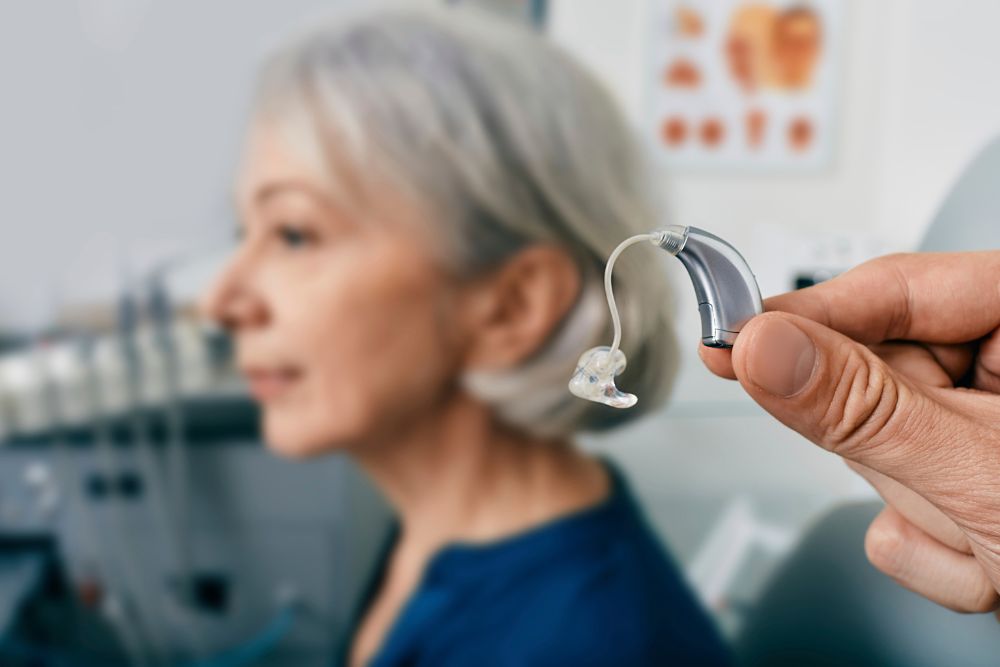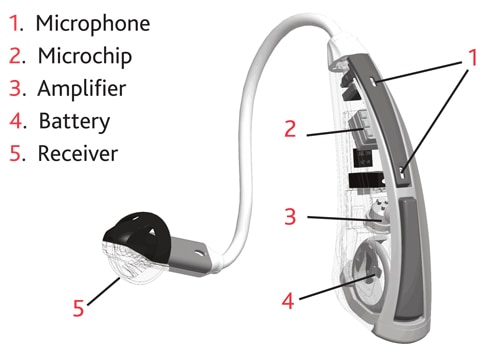How Hearing Aids Work: A Comprehensive Guide
Learn how hearing aids actually work to help those struggling with hearing loss.

The 3 key takeaways
- Hearing aids amplify and process sound — using a microphone, processor, amplifier, and receiver.
- Digital models adapt in real time — using a sound processor to sense your environment, cut background noise, and boost speech for clearer listening.
- Professional fitting makes all the difference — An audiologist tailors the settings to your specific hearing profile and lifestyle, ensuring comfort, improved communication, and long-term hearing health.
Hearing aids are wearable medical devices that take in sound, convert it into digital signals, amplify it based on your specific hearing loss, and deliver it directly into your ear. They consist of a microphone, amplifier/processor, receiver, and power source. Modern digital hearing aids automatically adjust to different environments, reducing background noise and enhancing speech clarity. Different styles—behind‑the‑ear (BTE), in‑the‑ear (ITE), receiver‑in‑canal (RIC), and bone‑conduction—fit various hearing profiles.
Your audiologist will evaluate your hearing and customize programming to suit your lifestyle and hearing loss. With proper care and realistic expectations, hearing aids can greatly improve communication, cognitive health, and quality of life.
Intro
If you’ve noticed hearing loss in yourself or a loved one and you’re ready to find solutions, understanding how hearing aids work is a helpful place to start. Whether you already have a diagnosis or are just starting to spot the signs of hearing loss, we know how much it can impact daily life.
In fact, nearly one-third of adults report some level of hearing loss, yet only 14% ever receive a professional diagnosis. This gap in hearing loss awareness highlights why many delay treatment—they’re unsure what hearing aids actually do or how effective they are.
This guide provides an evidence-based overview of modern hearing aids, including how they process sound, their key components, the differences between types, and what to expect from daily use. By understanding how these small but powerful devices work, you’ll be better equipped to choose a hearing aid that fits your needs and lifestyle.
What Are Hearing Aids and How Do They Work?
Hearing aids are small electronic devices worn in or behind the ear that amplify sound, making it easier for those with hearing loss to engage with others. They work by capturing environmental sounds, processing them, and delivering a clearer, louder signal to the ear. While hearing aids don’t restore normal hearing, they significantly improve access to speech and ambient sounds, supporting better social engagement, safety, and cognitive function.
Here are the five main components of hearing aids:
- Microphone: Picks up sound from the environment and converts it into an electrical signal. Most modern devices use omnidirectional microphones (which pick up sound from all directions) or directional microphones (which prioritize sound from a specific direction to reduce background noise).
- Amplifier: Increases the strength of the signal and processes it according to the user’s hearing needs. In digital hearing aids, this component works with the DSP to fine-tune sound, reduce feedback, suppress noise, and enhance speech clarity.
- Microchip or Digital Sound Processor (DSP): Found in nearly all modern hearing aids, this tiny chip converts analog signals into digital code, allowing for advanced real-time customization, environmental adaptation, and user-specific settings.
- Receiver (Speaker): Converts the processed signal back into sound and sends it into the ear canal.
- Battery or Power Source: Supplies the energy needed to run the device. Many hearing aids are rechargeable; others use disposable batteries that last 3 to 10 days.
(Image courtesy of Excel Audiology | Featured in the Audiologists.org Directory)
These components work in a precise sequence:
Step 1: The microphone picks up sound and sends it to the amplifier, which boosts and refines the signal.
Step 2: The digital processor enhances it further, applying settings like noise reduction or speech prioritization.
Step 3: Finally, the receiver delivers the optimized sound into the ear canal.
This process is consistent across all hearing aid types—including behind-the-ear (BTE), in-the-canal (ITC), and over-the-counter (OTC) models. What varies is the size and placement of these components, the level of customization, and available features.
Hearing Aid Technology Explained
Modern hearing aids are more than just sound amplifiers—they’re highly sophisticated devices designed to deliver clearer, more personalized sound. Two key areas of innovation shape how these devices function: the way they process sound (analog vs. digital) and how they transmit that sound to the inner ear (air conduction vs. bone conduction). Understanding these differences can help you choose a hearing aid that aligns with specific hearing needs and lifestyle preferences.
Analog vs. Digital Hearing Aids
Hearing aids come in two main formats: analog and digital. Today’s models are overwhelmingly digital because of how precisely they process sound.
Analog hearing aids use continuous electrical signals to amplify sound. They were once standard but are now largely outdated due to limited customization and basic amplification.
Not only do digital hearing aids have improved microphones and a DSP that allows for real-time enhancements, but they may also have features like:
- Noise reduction and feedback suppression to minimize distractions
- Bluetooth streaming, allowing audio from phones and TVs to connect directly to your device
- Telecoil (T-coil) technology enhances sound clarity during phone calls or in venues with hearing loop systems
- Programmable settings, letting audiologists tailor amplification to your hearing test results
- AI-powered sound processing that sense what’s happening around you—like speech, music, or traffic—and adjust automatically to deliver the clearest sound possible
Thanks to these advanced capabilities, digital hearing aids offer a more personalized and effective hearing experience than their analog predecessors.
Air-Conduction vs. Bone-Conduction Hearing Aids
Hearing aids also differ in how they deliver sound to the inner ear. Most hearing aids rely on air conduction, meaning they deliver amplified sound into the ear canal. From there, the sound waves pass through the eardrum and the small bones of the middle ear before reaching the inner ear (cochlea), where they are processed and transmitted to the brain.
Bone-conduction hearing aids, on the other hand, bypass the outer and middle ear entirely. These devices send sound vibrations directly through the bones of the skull to stimulate the inner ear. This type of hearing aid is typically used for individuals with conductive hearing loss or any outer or middle ear issues.
Types of Hearing Aids
As technology advances, so do the types of hearing aids available. These devices come in a range of styles—varying in size, placement, and visibility—to suit different types of hearing loss and personal preferences. While all models share the same basic components, each is tailored to meet specific hearing needs.
Behind-the-Ear (BTE)
BTE hearing aids sit behind the ear and connect to an earmold or dome that fits inside the ear canal via a clear acoustic tube. The external casing houses the electronic components, making it larger than other styles but often more powerful and easier to handle. BTE models are suitable for people with nearly any degree of hearing loss and are usually available with a wide range of features.
In-the-Ear (ITE) and In-the-Canal (ITC)
ITE hearing aids are custom-molded to fit entirely within the outer ear. These devices are larger than canal-style aids, making them easier to insert and remove. Plus, they offer room for additional features such as volume controls and directional microphones.
ITC hearing aids are a subtype of ITE models that are worn inside the ear canal; however, the outside portion of this hearing aid can still be seen. They’re compact and have a great ability to block out background noise and amplify conversations.
Receiver-in-Canal (RIC) and Completely-in-Canal (CIC)
RIC hearing aids are similar to BTE models but use a thin wire rather than a plastic tube to connect the casing to the receiver, which sits inside the ear canal. This design offers a more discreet appearance while delivering high-quality sound and maintaining ventilation in the ear canal. RIC models work well for most degrees of hearing loss.
CIC hearing aids fit completely within the ear canal, making them the smallest and most discreet option available. Due to their compact size, they typically have fewer features and a shorter battery life. CIC devices are best suited for adults with mild to moderate hearing loss and are generally not recommended for children or individuals with severe hearing loss.
Hearing Aid Fitting: What to Expect from an Audiologist
Getting the most from a hearing aid begins with a hearing evaluation. Audiometry tests measure how well you hear different pitches and volumes, identifying the degree and pattern of hearing loss. Based on these results, a hearing aid is selected and programmed to match your hearing profile. The fitting process also involves ensuring physical comfort and adjusting amplification levels for speech and background noise. Follow-up appointments are important for making adjustments as your brain adapts to new sound inputs.
Next Steps in Your Hearing Journey
Hearing aids are advanced medical devices that have been proven to increase quality of life by reducing the psychological, social and emotional effects of hearing loss. While they can’t restore normal hearing, the right device, when matched to your specific hearing profile and lifestyle, can significantly enhance communication, cognitive clarity, and day-to-day enjoyment. Be mindful, though: adaptation takes time, and follow-up visits with your audiologist are essential to fine-tune your device and maximize benefits.
Whether you’re considering a prescription model fitted by a hearing professional or exploring some of the best over-the-counter hearing aid options, understanding the differences is key. If you’re unsure where to start or are looking for professional guidance, reach out to a licensed audiologist to explore options tailored to your unique needs.
Use our Audiologist Explorer to find licensed professionals near you and book an appointment.
Frequently asked questions
What are the main components of a hearing aid?
A hearing aid contains a microphone that captures sound, an amplifier that adjusts and boosts audio, a receiver (speaker) that delivers sound into the ear canal, and a power source (either a rechargeable battery or a disposable cell). In digital models, a processor filters noise, suppresses feedback, and adapts to different listening environments.
How long do hearing aids last?
Most modern hearing aids last 3-7 years, depending on factors like device style, quality, and maintenance habits (like regular cleaning and moisture control).
How does a digital hearing aid differ from an analog one?
Analog hearing aids amplify all sounds equally, using continuous electrical signals. Digital hearing aids, now the most common type, convert sound into digital signals for precise processing. This allows for features like noise reduction, directional microphones, and environment-specific programming, resulting in a clearer sound and a more personalized listening experience.
Do hearing aids help with tinnitus?
Yes! Evidence shows that about 68% of tinnitus patients experience meaningful relief from tinnitus symptoms when using hearing aids, especially when paired with counseling or sound therapy. By increasing ambient sound input, hearing aids can reduce the brain’s focus on internal tinnitus activity and improve overall sound awareness. We even have a whole list of the best hearing aids for tinnitus according to our audiologists.
Can hearing aids be customized for individual hearing loss needs?
Yes. Prescription hearing aids are fully customizable. After a hearing test, a trusted audiologist programs the device to match your unique hearing profile, adjusting amplification levels across different frequencies. Digital hearing aids can also be fine-tuned over time to accommodate changes in hearing or improve performance in specific environments.
